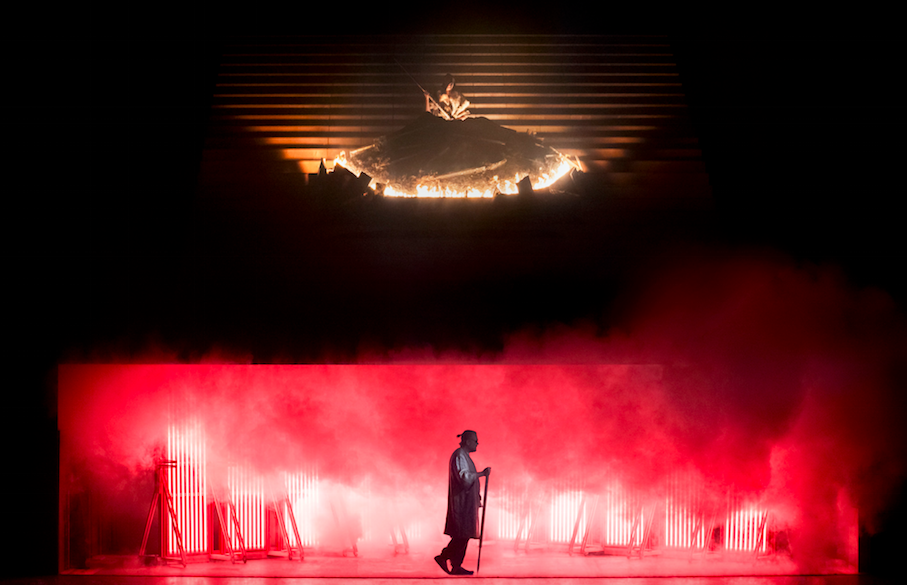The John Fulljames era at the Royal Danish Opera ended this summer. Here are some thoughts on his parting gesture, a new production of Wagner’s Die Walküre, whose messages of optimism came with their own bitter aftertaste.
This review was commissioned by and written for Opera News in New York. But a glitch meant it was never published. So here it is. Better late than never…
Wagner: Die Walküre Royal Danish Opera / 6.3.22

After an absence of 16 years, Wagner’s Ring returned to the Copenhagen Opera House in March. The audience had waited long enough. Early performances of this Die Walküre sold out and there was rapt attention in the auditorium for the duration of the opening night’s 5 hours. Artistic Director John Fulljames took charge of the staging, the last he will pilot while still in post. Conducting was Thomas Søndergård, who played timpani in the pit the last time the Ring was seen at this address, in the production by Kasper Holten that opened the new opera house and put the Royal Danish Opera on the world map.
Fulljames’s intelligent production couldn’t help but bring to mind the sorry administrative mess that will see him depart this summer, and his projected complete Ring apparently aborted after he was allegedly deemed insufficiently Scandinavian to run Denmark’s national company. Here was further evidence that the boss bows out with his head held high, his staging focusing hard on the hopelessness of Wotan’s quest for power and the sort of short-term schemes that are doomed to fail in the face of true vision and genuine humanity.
Wotan was on stage from the start, a Silicon Valley entrepreneur fixated on architectural models and spreadsheets, who assumed the status of a guru for his MacBook-wielding posse of office-bound Valkyries. When it all came tumbling down, he clasped to his chest a model of a broad staircase punctured by a giant spear, devastated that he – like Fulljames perhaps – would never get to see his plans come to fruition.
That model was the set we saw at full-scale on stage. Beneath the staircase, the under-class of Hunding and Sieglinde struggled in dirt and grime. Above it, Wotan’s elite workforce distributed Frappuccinos as they high-fived their corporation’s latest successes. It formed a strong image of the world in which we find ourselves, but proved even more resonant as a landscape of heartless ambition against which Siegmund and Brünnhilde’s visions of love and empathy proved so instantly transformative.
The dramatic power in Act II was severe, Brünnhilde’s initial exchange with Siegmund riven with a line of tension drawn from a combination of sadness and complete stasis, the Valkyrie rooted to a single spot on stage until the pivotal moment at which she could resist the power of human love no more. After a caricature of a meek, abused partner in Act I, the Sieglinde of Act II, debilitated by a deep sense of shock, proved strikingly moving to watch.
That role was taken by Ann Petersen, her apparently ageless voice clearer than ever and offering in tone color what it can sometimes lack in agility. Her characteristic ability to rise to the occasion, even in the middle of a phrase, gave her portrayal a vital dramatic edge. Bryan Register’s Siegmund proved his heldentenor credentials, its lyricism mingled with a sense of over-excitement adumbrating a potentially fine Siegfried. Morten Staugaard found unexpected depth and growl as Hunding and his laconic acting oozed malice. Hanne Fischer’s portrayal of Fricka was deeply satisfying. Only the assembled Valkyries underwhelmed, a fragile ensemble stocked with too many promising but inexperienced singers from the Opera Academy.
There was real quality where it mattered. Both Tomasz Konieczny’s Wotan and Trine Møller’s Brünnhilde were defined by their superior approach to text. Konieczny’s bright, gleaming, legato-infused baritone does so much with words and can apparently color a note even when his mouth is closed; his ‘Abschied’ was most moving at its quietest. Møller focused on meaning and diction, drawing attention away from the size of a voice that, in the end, seemed big enough anyway.
Søndergård paced everything to the text and with ample elasticity. Strings were occasionally lost in the orchestral balance – not normally a problem with the Royal Danish Orchestra – and detail in the prelude to Act II was frustratingly low. But grandeur and scintillating rapture were kept in good balance. Ultimately, ambition and power were trumped by love and beauty, realized as effectively via the notes we heard as by the tenderness we saw.